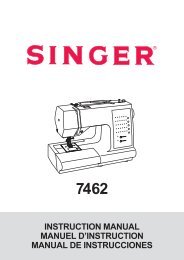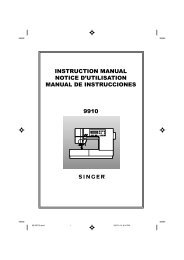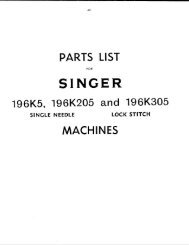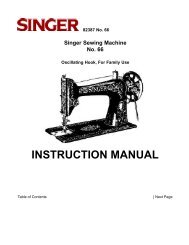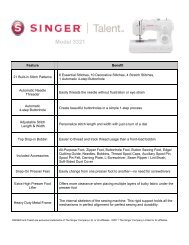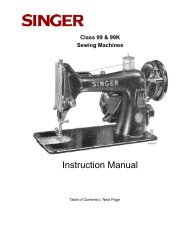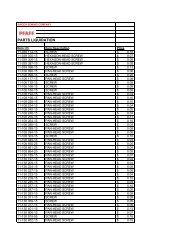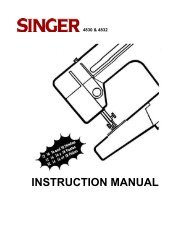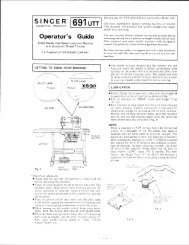Instruction Book Libro de Instrucciones Livret d'Instructions ... - Singer
Instruction Book Libro de Instrucciones Livret d'Instructions ... - Singer
Instruction Book Libro de Instrucciones Livret d'Instructions ... - Singer
You also want an ePaper? Increase the reach of your titles
YUMPU automatically turns print PDFs into web optimized ePapers that Google loves.
Blindstitch<br />
(only for machines with 5, 6, 8<br />
and 10 stitches)<br />
Blindstitching provi<strong>de</strong>s a durable hem finish that<br />
can be used on a variety of different weight<br />
fabrics. Blindstitching takes a little paractice,<br />
however, so make a test sample first.<br />
Recommen<strong>de</strong>d Settings<br />
Stitch Selection: Blindstitch (C)<br />
Needle Position:<br />
Stitch Width:<br />
12 3 4 5<br />
Stitch Length: 1-½to2-½ Foot: Special for blindstitch # 9<br />
Needle Plate: General Purpose (A)<br />
Prepare the hem by folding it and pressing it in<br />
the usual way. You may want to bastle the hem<br />
to hold it in place, as shown. If so, be sure to<br />
place the basting at least ½ inch (12mm) bellow<br />
the top edge of the hem allowance.<br />
With the wrong si<strong>de</strong> of fabric uppermost, turn<br />
the hem un<strong>de</strong>r, as shown, creating a soft fold<br />
from the top edge of hem. Pin or bastle all three<br />
layers together in place.<br />
Position the hem un<strong>de</strong>r the presser foot with the<br />
soft fold rest against wall of the gui<strong>de</strong>, as shown.<br />
Lower the presser foot and begin sewing<br />
making certain the straight stitches fall on the<br />
edge of the hem and the zig-zag stitches fall<br />
on the edge of the hem and the zig-zag<br />
stitches just pierce the soft fold of the work.<br />
Adjust stitch width if necessary. While<br />
stitching, gui<strong>de</strong> the hem edge in a straight line<br />
and feed the soft fold evenly against the wall of<br />
the gui<strong>de</strong>.<br />
If layers of fabric are pinned together, remove<br />
pins as you come to them. Do not sew over<br />
pins.<br />
Puntada invisible<br />
(solamente para máquinas con<br />
5, 6, 8 y 10 mo<strong>de</strong>los <strong>de</strong> puntos)<br />
La puntada invisible aporta un acabado<br />
dura<strong>de</strong>ro para los dobladillos que pue<strong>de</strong>n<br />
utilizarse en una variedad <strong>de</strong> tejidos <strong>de</strong> pesos<br />
diferentes. La puntada invisible precisa <strong>de</strong> un<br />
poco <strong>de</strong> práctica, por lo tanto, haga primero una<br />
prueba.<br />
Posiciones recomendadas<br />
Selección punto: Puntada Invisible (C)<br />
Posición aguja:<br />
Anchura punto:<br />
12 3 4 5<br />
Longitud punto: 1-½ a 2-½<br />
Prensatelas: Especial para<br />
puntada invisible # 9<br />
Plancha aguja: Uso general (A)<br />
Prepare el dobladillo doblándolo y<br />
planchándolo en la forma usual. Pue<strong>de</strong> hilvanar<br />
el dobladillo para asegurarlo. Si así lo hace,<br />
asegurese <strong>de</strong> situar el hilván a 12mm, por lo<br />
menos, por <strong>de</strong>bajo <strong>de</strong>l bor<strong>de</strong> superior <strong>de</strong> la<br />
tolerancia <strong>de</strong>l dobladillo.<br />
Con el revés <strong>de</strong>l tejido en primer lugar, gire el<br />
dobladillo hacia abajo, como se muestra,<br />
creando un doblez blando, <strong>de</strong>s<strong>de</strong> el bor<strong>de</strong><br />
superior <strong>de</strong>l dobladillo. Coloque alfileres o<br />
hilvane los tres pliegues juntos en su lugar.<br />
Colocar el dobladillo <strong>de</strong>bajo <strong>de</strong>l prensatelas<br />
con el doblez blando <strong>de</strong>scansando contra la<br />
pared <strong>de</strong> la guía, como se muestra.<br />
Baje el prensatelas y empiece a coser<br />
asegúrandose que los puntos rectos caigan<br />
sobre el bor<strong>de</strong> <strong>de</strong>l dobladillo y los puntos en<br />
zig-zag justo sobre el doblez blando <strong>de</strong> la<br />
labor. Ajuste el ancho <strong>de</strong>l punto si fuese<br />
necesario. Mientras cose guíe el bor<strong>de</strong> <strong>de</strong>l<br />
dobladillo en línea recta y arrastre con<br />
suavidad el doblez blando contra la pared <strong>de</strong><br />
la guía.<br />
Si los pliegues <strong>de</strong>l tejido están sujetos con<br />
alfileres, quítelos según se aproxima a ellos.<br />
No cosa sobre los alfileres.<br />
46 43<br />
0<br />
4<br />
3<br />
1<br />
1<br />
2<br />
2<br />
3<br />
3<br />
2<br />
4<br />
5<br />
1<br />
2<br />
3<br />
4<br />
5<br />
Réglage <strong>de</strong> la<br />
longueur <strong>de</strong> point<br />
Selon la longueur <strong>de</strong> point choisie, <strong>de</strong> 1 à 5, le<br />
zig-zag sera plus ou moins ouvert.<br />
Le chiffre le plus élevé donnera le zig-zag le plus<br />
ouvert.<br />
La position du sélecteur entre 0 et 1 sera utilisée<br />
pour faire le point <strong>de</strong> bourdon. Dans cette zone,<br />
les points <strong>de</strong> zig-zag seront très rapprochés et<br />
formeront une surface unie et satinée.<br />
Tension du fil d’aiguille<br />
Les graduations du bloc tension permettent<br />
d’adapter le réglage <strong>de</strong> la tension supérieure à<br />
l’épaisseur du fil et du tissu.<br />
Lorsque la tension est bien réglée, le point est<br />
régulier et uniforme (1).<br />
Si la tension est trop serrée, le point sera tendu<br />
(2) et plissera le tissu. Desserrez la tension en<br />
tournant le disque vers un chiffre moins élevé.<br />
Si la tension est trôp lâche, vous constaterez <strong>de</strong>s<br />
bouclettes sur l’envers du travail (3). Pour<br />
resserrer la tension, tournez le disque vers un<br />
chiffre plus élevé.



